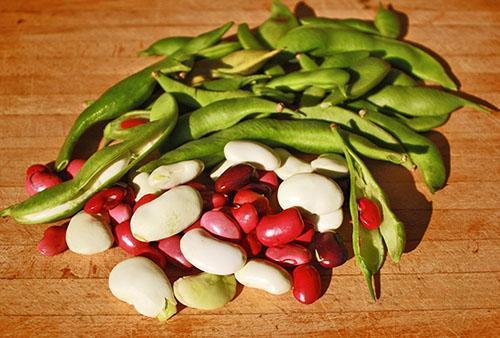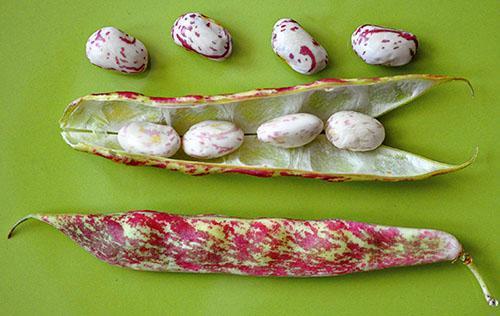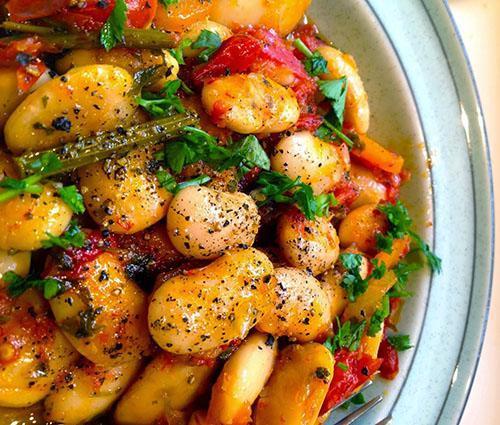Features of use, benefits and harms of beans
 Legumes were among the first to be used by humans for food. Undemanding to growing conditions, early ripening and fairly productive plants have become an affordable and nutritious food for representatives of many nations. Beans are a native of South America, where archaeologists have discovered the beans of this vegetable crop in layers dating back to the times of the ancient civilization of the Aztecs. Since then, the culture has spread throughout the world, and thanks to its beneficial properties, beans have become a welcome guest on tables around the world.
Legumes were among the first to be used by humans for food. Undemanding to growing conditions, early ripening and fairly productive plants have become an affordable and nutritious food for representatives of many nations. Beans are a native of South America, where archaeologists have discovered the beans of this vegetable crop in layers dating back to the times of the ancient civilization of the Aztecs. Since then, the culture has spread throughout the world, and thanks to its beneficial properties, beans have become a welcome guest on tables around the world.
Bean seed composition and calorie content

- 54.5 grams of carbohydrates, of which 4.5 grams are sugars, and the rest is starch;
- 22.5 grams of protein;
- 1.7 grams of fat;
- 14 grams of moisture;
- 3.9 grams of fiber.
Almost a quarter of the beans consists of protein valuable for the human body, which already determines its significant importance in the diet of modern people. In addition, beans are rich in vitamins B1, B2, B3 and B6, B9, E and PP. What else is useful for beans? Mature seeds and succulent valves contain substances important for human life, such as fluorine and iron, phosphorus and calcium, potassium and molybdenum, iodine, manganese and magnesium, as well as copper, zinc and sodium.
The high calorie content of beans should be taken into account if you want to lose weight, as well as for pregnant women who control body weight. For 100 grams of seeds, depending on the variety, there are from 298 to 301 kcal. But green pods, which have no less useful properties than shelling beans, contain only 31 kcal.
Beans can rightfully be considered a product that contains almost all the substances necessary for a person in the most correct proportions.
 Bean proteins are absorbed surprisingly easily, which is facilitated by the presence in the composition of vitamins, the most important among which is ascorbic acid and compounds belonging to group B. Vitamin PP supports protein metabolism, promotes the efficiency of the cardiovascular and nervous system. Also, nicotinic acid supports the condition of the intestinal mucosa, participates in the digestive system and has a beneficial effect on blood pressure.
Bean proteins are absorbed surprisingly easily, which is facilitated by the presence in the composition of vitamins, the most important among which is ascorbic acid and compounds belonging to group B. Vitamin PP supports protein metabolism, promotes the efficiency of the cardiovascular and nervous system. Also, nicotinic acid supports the condition of the intestinal mucosa, participates in the digestive system and has a beneficial effect on blood pressure.
Useful properties of beans
 Bean seeds are also useful in the minerals that make up them. This is a natural source of iron, which is in great demand in conditions close to anemia, when tissues and organs due to a lack of this element are threatened with oxygen starvation. The useful properties of beans are invaluable for infectious diseases, the threat of seasonal colds and viral diseases. And phosphorus and magnesium become excellent support for vision, heart and blood vessels.
Bean seeds are also useful in the minerals that make up them. This is a natural source of iron, which is in great demand in conditions close to anemia, when tissues and organs due to a lack of this element are threatened with oxygen starvation. The useful properties of beans are invaluable for infectious diseases, the threat of seasonal colds and viral diseases. And phosphorus and magnesium become excellent support for vision, heart and blood vessels.
The main effect of bean dishes is on the digestive system, stimulating the cleansing of the body from pathogenic microorganisms, toxins and toxins. Hearty and tasty beans are the prevention of atherosclerosis, hypertension and diabetes. Therefore, beans are often recommended for people of mature and older age.
With the observed weakened intestinal motility, useful beans in the composition of culinary dishes will certainly activate digestion, make all the organs involved in the process work clearly and effectively. And besides this, all accumulated toxins, undigested food residues and toxins will leave the intestines.
Beans also play the role of a kind of brush in relation to cholesterol. This useful property of beans has long been known to doctors, who advise everyone who is prone to atherosclerosis or already feels its negative effects on the menu.
Despite the high calorie content, beans are a component of dietary and medical nutrition with a mass of ailments and metabolic disorders. Also, beans find a place in the diet of people experiencing the effects of prolonged physical and nervous stress. Dishes from the beans of this plant can restore strength, restore mental balance and strengthen the immune system. That is why doctors recommend beans in case of a threat or already developing tuberculosis.
 The diuretic property of beans was also noted, which, together with the anti-inflammatory effect, makes it possible to talk about the benefits of using beans for various diseases of the genitourinary system, including cystitis and urolithiasis.
The diuretic property of beans was also noted, which, together with the anti-inflammatory effect, makes it possible to talk about the benefits of using beans for various diseases of the genitourinary system, including cystitis and urolithiasis.
There is a legend that the crushed legume seeds were part of the powder that Cleopatra once used.
Today more effective cosmetics are available to women, but it is quite possible to use the beneficial properties of beans for the benefit of the skin. Boiled bean gruel will help normalize the separation of sebum, relieve irritation and gently tighten wrinkles. Even a decoction of seeds has a similar effect.
Precautions
 With the great benefits of beans, the harm from eating beans is no less weight, if you do not take into account some simple rules. First of all, do not eat seeds and leaves that have not been heat treated. The fact is that, in addition to useful substances, beans contain a number of proteins and carbohydrates, which are extremely difficult or even impossible for the body to assimilate. In addition, brightly colored, red or black beans contain glycosides that are toxic to the body.
With the great benefits of beans, the harm from eating beans is no less weight, if you do not take into account some simple rules. First of all, do not eat seeds and leaves that have not been heat treated. The fact is that, in addition to useful substances, beans contain a number of proteins and carbohydrates, which are extremely difficult or even impossible for the body to assimilate. In addition, brightly colored, red or black beans contain glycosides that are toxic to the body.
In order to feel the benefits of beans, and not harm, they are not only boiled before use, but also soaked for several hours. This measure allows the bulk of the harmful substances to leave the product and go into the water.
And yet glycosides, an abundance of fiber and protein can have a negative effect on well-being, causing pain and a feeling of heaviness in the stomach. A striking symptom after eating insufficiently boiled and soaked beans is abundant gas formation and even signs of poisoning. Given these features, you should be extremely careful to use beans during pregnancy, otherwise painful cramps, harmful to both mother and baby, are not excluded. When the expectant mother wants to pamper herself with her favorite bean dish, you can add some fennel seeds to the water where the beans are boiled or dill... And spice up your portion with the fresh herbs of these herbs that reduce gas formation.
 If there are such warnings about pregnant women, is it possible for a nursing mother to have beans? Since a child can receive both some harmful substances and allergens through milk, it is better to avoid beans when breastfeeding if there are negative reactions to the product of the mother's body. Otherwise, the recommendations are the same as for bean dishes during pregnancy. It is important to remember that red beans are more dangerous for at-risk groups than white beans.
If there are such warnings about pregnant women, is it possible for a nursing mother to have beans? Since a child can receive both some harmful substances and allergens through milk, it is better to avoid beans when breastfeeding if there are negative reactions to the product of the mother's body. Otherwise, the recommendations are the same as for bean dishes during pregnancy. It is important to remember that red beans are more dangerous for at-risk groups than white beans.
Also, you should not get carried away with beans for the elderly, but with an exacerbation of pancreatitis, gastritis and peptic ulcer disease, cholecystitis and colitis, this product is completely contraindicated.